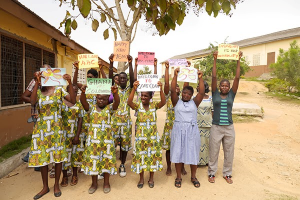 After the 10 hour transatlantic flight and a 4 hour bus ride, we have arrived! Our first days in Ghana have already been filled with learning and a range of cultural experiences. We rang in the New Year in a country new to most of our group by attending a local church service where Dr. Crowley spoke about the purpose of our trip and our work. We also got to unexpectedly share in the celebration of a young man’s completion of his apprenticeship by participating with his family and friends in pouring baby powder on him, and joining in a drum and dance circle on the beach that we drove past.
After the 10 hour transatlantic flight and a 4 hour bus ride, we have arrived! Our first days in Ghana have already been filled with learning and a range of cultural experiences. We rang in the New Year in a country new to most of our group by attending a local church service where Dr. Crowley spoke about the purpose of our trip and our work. We also got to unexpectedly share in the celebration of a young man’s completion of his apprenticeship by participating with his family and friends in pouring baby powder on him, and joining in a drum and dance circle on the beach that we drove past.
In a serious and grounding experience, we visited two different slave forts that were active during the transatlantic slave trade; Elmina and Cape Coast. This was powerful for all of us as we were reminded of this sad chapter of human history as we walked through the dark dungeons and punishment cells. We walked away from this experience with the main message “May humanity never again perpetrate such injustice against humanity.”
We were fortunate to be invited to attend a traditional ceremony called “Eldina Brunya” which is unique to Elmina and occurs on the first Thursday in January every year. The ceremony is held to remember their ancestors who have since passed on. This is also the day they consider to be Christmas. We were warmly welcomed into a local family’s home to experience and participate in their remembrance and celebration. The ceremony included blessings of both family and ourselves, reading of the deceased ancestors, sharing of libations, songs, and dancing.
After the ceremony, we had our first experience with the work that has been being done among TC and our colleagues in Ghana over the years. We headed to Mary Osei’s Unit School in Cape Coast to see how she and her staff implemented the AAC strategies that were introduced during last year’s professional development. Needless to say, the results were impressive. Schedules and calendars were being used in every classroom. When they needed additional pocket calendars, they decided to make their own! We were all blown away by their innovations and creativity. Anthony, another teacher at the school, showed us examples of the children’s communication books and passports and explained how the children used them. Next, Mary described the goals for the vocational classroom which focuses on teaching the students how to make bags from kente and batik fabrics which are sold in local markets. We were so impressed by the work the students and teachers are doing.
Later we reached new heights while doing a canopy walk through Kakum National Park. The walkways were suspended 150 meters above the ground. We were assured that they could hold up to 2 elephants! With all of these experiences in mind so far, we began discussing and preparing for our upcoming professional development weekend.
More to come!
Thanks to Miki Shibata, Shannon Lukovich and Jenn Stanis for this post

![[feed link]](/wp-content/plugins/rss-just-better/rss-cube.gif)